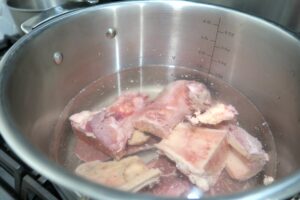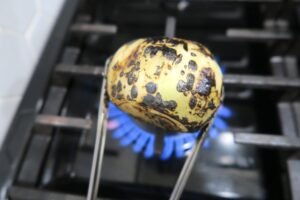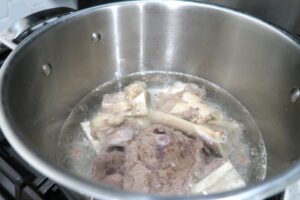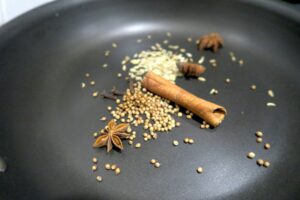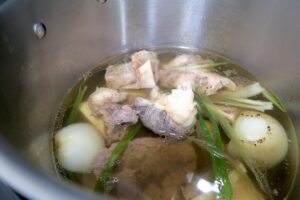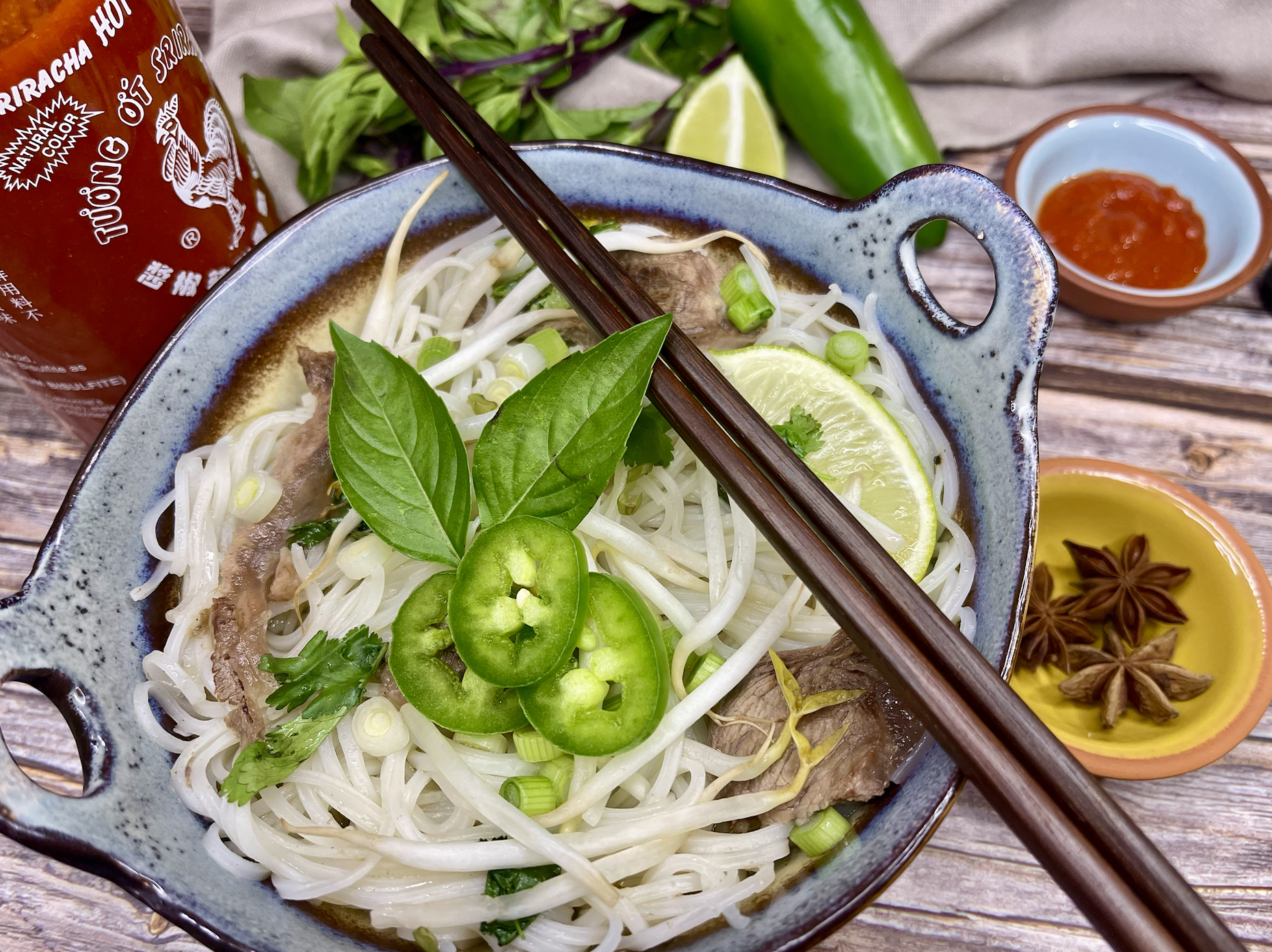
Let’s dive into the art of this authentic Vietnamese Pho recipe! Discover the joy of creating a soul-warming bowl of Vietnamese noodle soup with this simple and delicious recipe! The made-from-scratch broth, infused with the traditional blend of cinnamon, star anise, and cardamom (and other spices), is a flavor-packed experience that will keep you coming back for more with every spoonful.
Keep reading to learn how to prepare this Vietnamese Pho Recipe.
TABLE OF CONTENTS
When you return from a trip, there is always at least one dish you ate that you immediately miss and want to eat again. For us, there were a couple: Bahn Mi and Pho. And for drinks, the iconic Vietnamese egg coffee (well, this one is just for me, as Dwayne doesn’t drink coffee)! While we still need to make a Banh Mi, we did get to cook a delicious bowl of traditional Pho.
We really wanted to find a traditional Vietnamese Pho recipe, and after some research, we concluded this was a good one, as several popular food blogs used it and had great reviews. Once we cooked it, we were so happy to taste it and realized it was exactly like the one we ate in various Vietnamese restaurants while traveling across the country from North to South.
This Vietnamese Pho Recipe is easy to make but is a long process.
The broth must be cooked/simmer for 3+ hours. The good news is that the active part of the process is fast; the rest is more of a waiting game. To make our life easier, I cooked it the night before and then refrigerated it so that I just needed to assemble it the following night when we were ready to eat it for dinner. I think this made the pho broth even tastier as it sat for several hours with the species, bones, etc.
WHAT IS PHO?
Pho is a quintessential Vietnamese soup that has gained international acclaim for its exquisite flavors and comforting qualities. It is renowned as the national dish of Vietnam, embodying the country’s rich culinary heritage. This beloved soup typically features a fragrant broth meticulously prepared by simmering beef or chicken bones with a medley of aromatic spices such as cinnamon, star anise, cloves, and ginger.
The heart of Pho lies in its assembly – thin rice noodles are submerged in the flavorful broth, then generously garnished with slices of tender meat, usually beef (Pho Bo) or chicken (Pho Ga). Fresh herbs like cilantro, basil, and bean sprouts add vibrancy and freshness to the dish. Pho is often personalized with condiments like lime, chili, and hoisin sauce, allowing individuals to tailor the flavors to their liking.
As the national dish of Vietnam, Pho holds a special place in the hearts and palates of the Vietnamese people, serving as a symbol of culinary identity and cultural pride. Its popularity has transcended borders, making it a global favorite and an ambassador of Vietnamese gastronomy.
WONDERING HOW TO PRONUNCE PHO? LISTEN HERE.
PHO BROTH: THE KING ELEMENT OF THE RECIPE
The broth is considered the king element of the pho recipe because it serves as the foundation for the entire dish, providing the rich, complex flavors that characterize this Vietnamese noodle soup. There are several reasons why the broth is crucial to the success of a good pho:
• Flavor Base: The broth is responsible for infusing the entire dish with a deep, savory flavor. The slow simmering of bones, spices, and aromatics allows the flavors to meld and develop over time, creating a complex and aromatic broth.
• Aromatics and Spices: The unique combination of aromatics and spices, such as ginger, star anise, cloves, cinnamon, and cardamom, contribute distinctive and fragrant notes to the broth. These elements give Pho its characteristic taste and make it stand out from other soups.
• Umami: The use of beef bones, particularly those with marrow, helps create a broth rich in umami, the savory and meaty flavor that is a key component of many delicious dishes. This umami is fundamental to the overall taste experience of Pho.
• Versatility: While the broth is the foundation, it also serves as a versatile canvas. The toppings and condiments added to the bowl provide additional layers of flavor and texture, but they rely on the flavorful broth to tie the entire dish together.
• Balance: A well-made pho broth achieves a delicate balance of savory, sweet, salty, and slightly spicy flavors. Achieving this balance is crucial for a harmonious and satisfying bowl of Pho.
• Nourishment: Traditionally made with bone marrow and connective tissues, the pho broth is not only flavorful but also nutrient-rich. It provides a source of collagen, minerals, and other nutrients that contribute to the overall comfort and nourishment associated with a good bowl of soup.
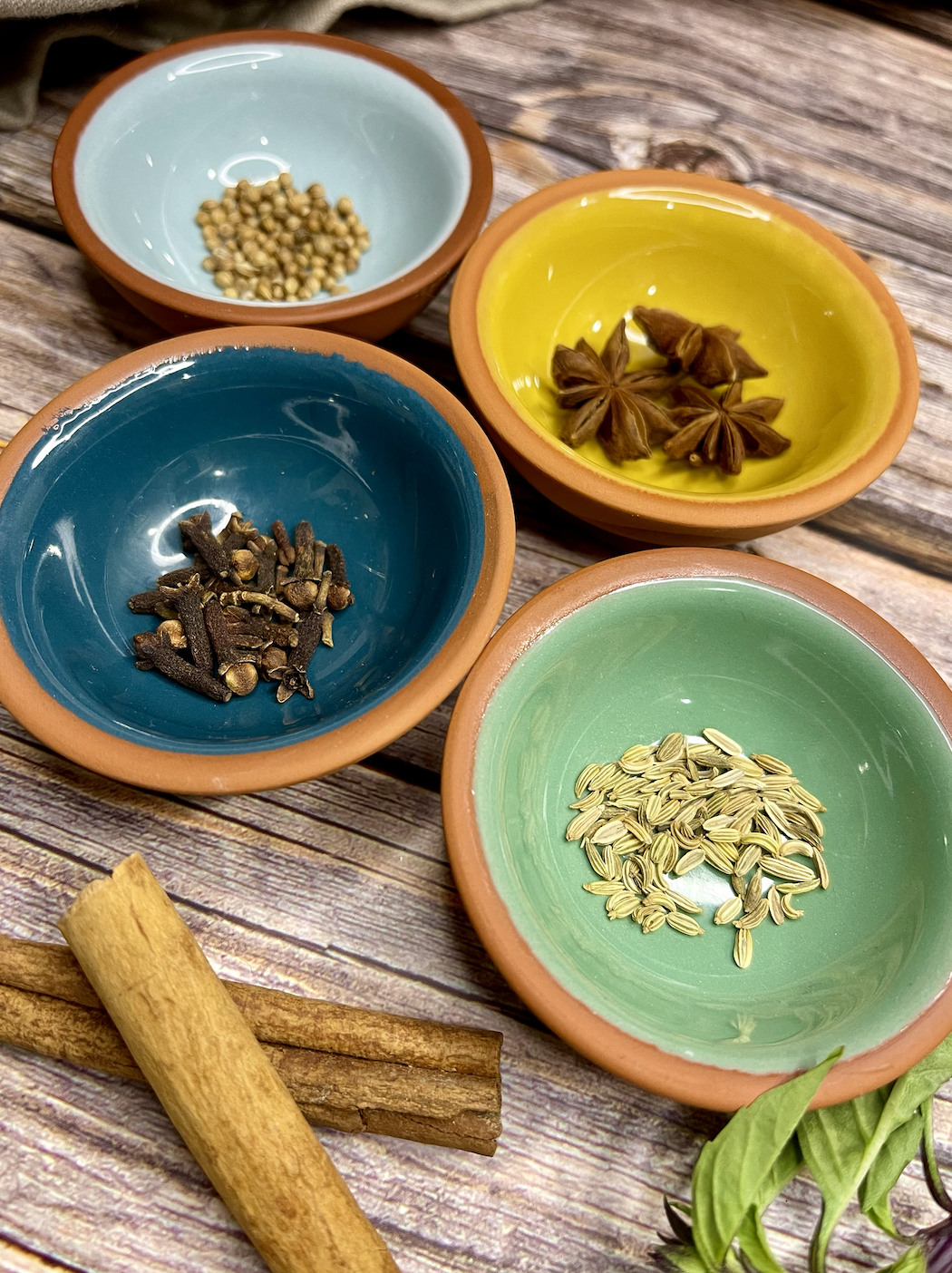
HOW TO MAKE PHO BROTH FROM SCRATCH
Making the Pho broth is, surprisingly, a straightforward process. Still, it does require a long time when cooked traditionally – using a pressure cooker can shorten the cooking time, but I wonder if to the detriment of flavor. What I learned from comparing several online recipes and also asking around while traveling in Vietnam is that there are a few crucial steps to follow to make the broth incredibly flavorful:
-
Use both bones and meat
-
Toast the spieces (cinnamon, fennel seeds, coriander seeds, star anise, cloves)
-
Char the ginger and onions
-
Use fish sauce to replace the majority of the salt - please keep in mind that some fish sauces contain shell fish - double check the ingredients in case of allergy
BEST BEEF TO USE FOR YOUR VIETNAMESE PHO RECIPE
In this recipe, we used three types of beef:
• Marrow bones – Some recipes add other meaty bones, such as oxtail bones. Make sure the marrow bones are cut to reveal some of the marrow inside so it can leach into the broth (you can ask the butcher to prep them for you).
• Beef chuck – Some other recipes use brisket (which appears to be the beef of choice with Pho vendors in Vietnam), but we used chuck, and the flavor was impeccable. Alternatively, you can also use gravy beef.
• Beef sirloin – Ask your butcher to cut a few paper-thin slices for you. This meat is not used to cook the broth, but you will add it raw when it’s time to serve the Pho – no worries, the hot broth will cook the meat.
KEY SPICES FOR AUTHENTIC PHO FLAVOR
The traditional spices used in Pho give it a warm, aromatic depth:
• Star anise
• Cloves
• Cinnamon stick
• Fennel seeds
• Coriander seeds
These spices are toasted before adding to the broth to enhance their flavor and aroma.
PHO TOPPINGS AND CONDIMENTS
Serve Pho hot with an array of condiments on the side, allowing diners to customize their bowls:
• Bean sprouts
• Fresh basil and cilantro
• Sliced jalapeños
• Lime wedges
• Hoisin and Sriracha sauces
Are you ready to try This Vietnamese Pho Recipe? Ok, let’s start cooking!
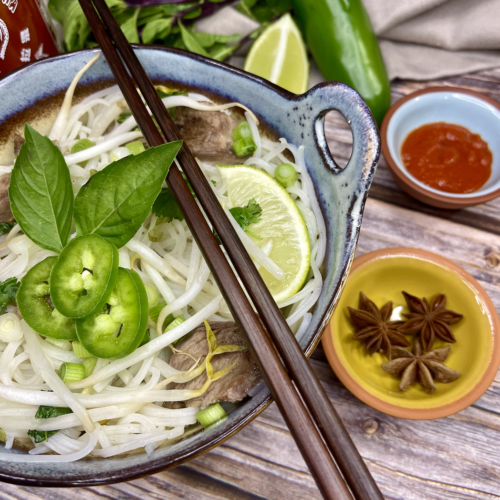
AUTHENTIC VIETNAMESE PHO REPICE
Ingredients
FOR THE BROTH YOU WILL NEED:
- 1.5 pounds beef marrow cut lengthwise and into pieces
- 0.5 pounds beef chuck cut into two pieces
- 1 1.5-inch (4 cm) piece ginger Do not peel
- 0.5 onion
- 1 scallion cut lengthwise into 2 or 3 pieces
- 4 ounces dry or fresh noodles
- 1 and 1/4 tbsp fish sauce
- 1/4 tbsp salt
- 5 cups water
- 1 tbsp sugar
SPICES:
- 2 star anise
- 2 cloves
- 1/4 cinnamon stick
- 1/2 tsp fennel seeds
- 1/2 tsp coriander seeds
GARNISH/TOPPINGS:
- 1.50 ounces beef sirloin cut paper-thin
- sliced chili
- chooped scallions
- bean sprouts
- cilantro
- Thai basil
- lime wedges
- Hoisin and/or Sriracha sauce
Instructions
CLEANSE THE MEATS FOR CLEANER BROTH
- In a sizable stockpot, combine beef bones and chuck, ensuring they are submerged in water. Bring to a boil and let it simmer for 5 minutes. Drain the contents in a colander and meticulously cleanse the stockpot. This step effectively eliminates impurities and scum, resulting in a significantly cleaner broth.

MAKE THE PHO BROTH
- While the meats boil, char the ginger and onions individually. Utilize tongs to expose the piece of ginger and onion to an open flame on a gas burner. Rotate them until they acquire a light blackened appearance and a fragrant aroma (about 5 minutes). Remove charred skins thoroughly from both the ginger and onion (rinse them under the water if needed).

- Add water to the stockpot and bring to a boil. Transfer the bones and meat back to the pot, along with the charred and cleaned ginger and onions. Add the scallions, fish sauce, salt and sugar.

- Toast the spices (star anise, cloves, cinnamon stick, cardamom, fennel seeds, and coriander seeds) in a dry pan over medium-low heat for approximately 3 minutes, or until they become fragrant. Place the toasted spices in a piece of cheesecloth, then secure it by either tying a knot or using kitchen string. Add the spice bundle to the broth. If cheesecloth is unavailable, you can add the spices directly to the broth (they will be strained out at the end).

- Lid the pot and let it simmer for an additional 4 hours. Sample the broth and fine-tune the seasoning by incorporating more salt, sugar, and/or fish sauce as necessary.

- Strain the broth (saving the chuck pieces) and keep it warm
- Cook the fresh or dry noodles based on the cooking instructions on the package or until they are slightly soft (they will continue cooking in the broth anyway).
ASSEMBLE THE PHO
- Add the cooked noodles, the raw sirloin slices, pices of chuck meat, bean sprouts, cilantro, Thai basil, and chopped scallions in an individual deep bowl, a
- Serve some lime wedges, sliced chili, chop scallions, cilantro, and Hoisin and/or Sriracha as a side to add to the Pho based on preference.
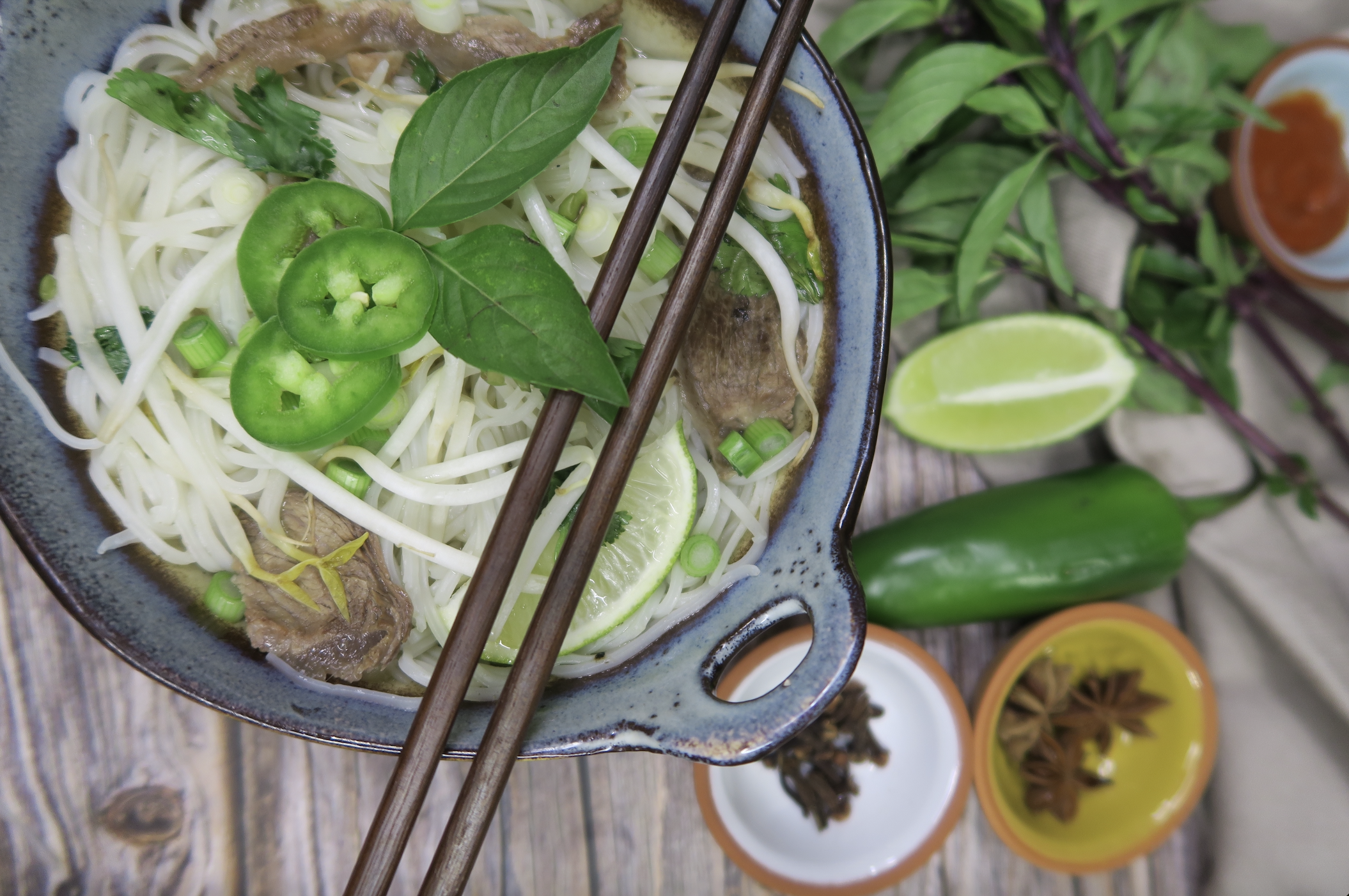
NUTRITION AND HEALTH BENEFITS OF PHO
Pho is not only delicious but nutritious. The long-simmered bone broth is rich in collagen and minerals, supporting joint and gut health. Fresh herbs, lean proteins, and vegetables add a wealth of vitamins and antioxidants.
COMMON MISTAKES TO AVOID WHEN MAKING PHO
• Boiling the Broth: Always simmer; boiling makes the broth cloudy.
• Skipping Toasting: Toasting spices releases essential oils and enhances aroma.
• Over-seasoning: Add fish sauce and salt gradually for balanced flavors.
FREQUENTLY ASKED QUESTIONS (FAQs)
What’s the difference between Pho and Ramen?
Pho is a Vietnamese soup with a clear, aromatic broth and rice noodles, while Ramen is a Japanese dish with wheat noodles and a variety of broths, often richer and thicker.
How long should I simmer Pho broth?
The broth should simmer for at least 3 hours for optimal flavor.
Can I make Pho with chicken instead of beef?
Yes! Substitute beef bones with chicken bones for a lighter, yet flavorful Pho Ga.
Is Pho gluten-free?
Yes, the traditional Pho is gluten-free as it uses rice noodles and a gluten-free broth.
Can I freeze Pho broth?
Absolutely. Freeze it in airtight containers for up to three months. When ready to serve, reheat it on the stove, but do not boil it, as this can cause cloudiness and alter the flavor.
What is the best way to pronounce Pho?
Pho is pronounced “fuh” with a short, soft sound.
SHOP OUR FAVORITE KITCHEN PRODUCTS
DID YOU TRY THIS RECIPE?
We would love to see your culinary masterpiece! Share your photos or videos with us on Instagram by mentioning @YourTravelFriends and using the hashtag #YTFood.
Your feedback is invaluable to us! If you have any advice or recommendations regarding this recipe, please don't hesitate to leave a comment below or contact us on Instagram.
For more exciting world recipes, click here. Happy cooking!



